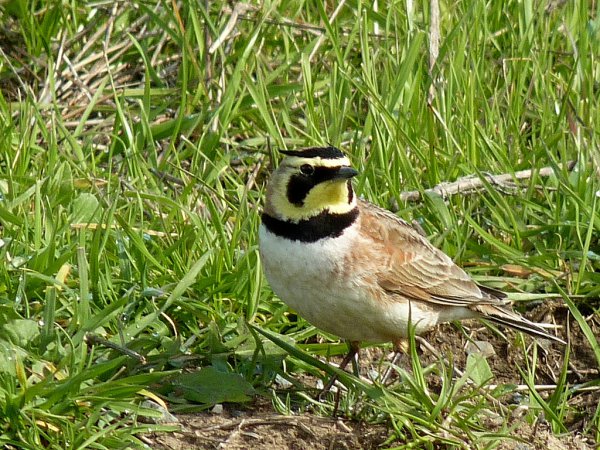Horned Lark
Eremophila alpestris ssp. praticola, HOLA
Size and Shape
L: 7.25” WS: 12” WT: 1.1oz Slightly smaller than a house sparrow. Characteristic “horns” on head. Long (ish) wings and short, square tail.
Colour Pattern
Plumage is pale sandy-red. Black lores extends down to the moustachial area to create a downward-crescent-shaped mask. Ear coverts are pale sandy colored, with a white supercilium above. Between supercilium and top of head are black stripe which extrudes to create a horn shape (hence the name). Yellow throat with a dash of yellow on the forehead. Top of breast is black and shaped like a bib, rest of breast is white.
Tail is dark, with pale sandy central feathers and thin white edges on either side.
Behaviour
Can occur in flocks of hundreds, and mix with longspurs (e.g. CCLO) or snow buntings. Feed on seeds and insects gleaned from low vegetation or on the ground. Crouches close to the ground while feeding, occasionally standing up taller to look around.
Call
Song is high and weak, with a few weak lisping chirps followed by a rapid tinkling, rising warble reek trik treet tritilititi treet. _Common Call is _tsu.
Flight Call: high, soft, weak, lisping see-tu or see-titi and other variations, with some buzzing notes.
Habitat
Common in expansive open areas, with barren/sparsely vegetated ground, such as beaches, plowed fields, and edges of airport runways.
Macaulay Library Links
http://macaulaylibrary.org/search?location_id=&location_type_id=&location=&recordist=&recordist_id=&catalogs=&behavior=&behavior_id=&tab=video-thumb&taxon_id=12002033&taxon_rank_id=67&taxon=horned+lark
